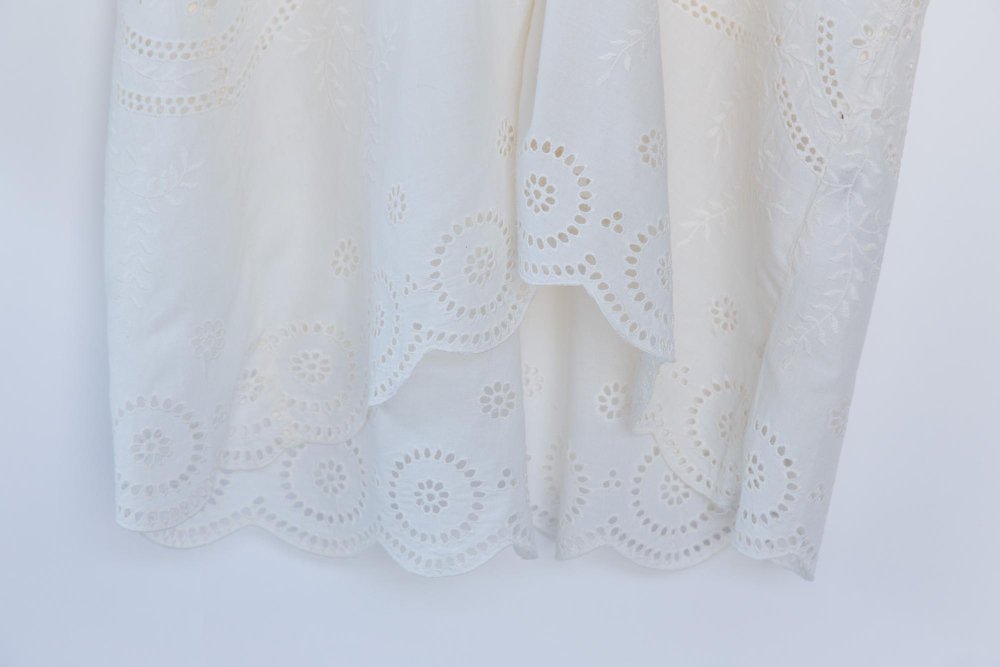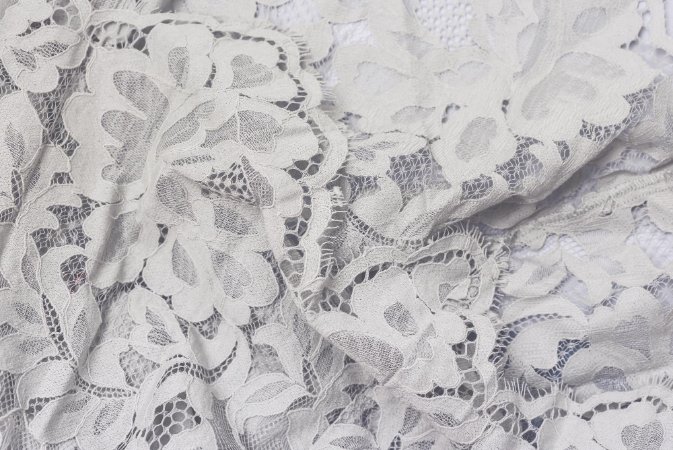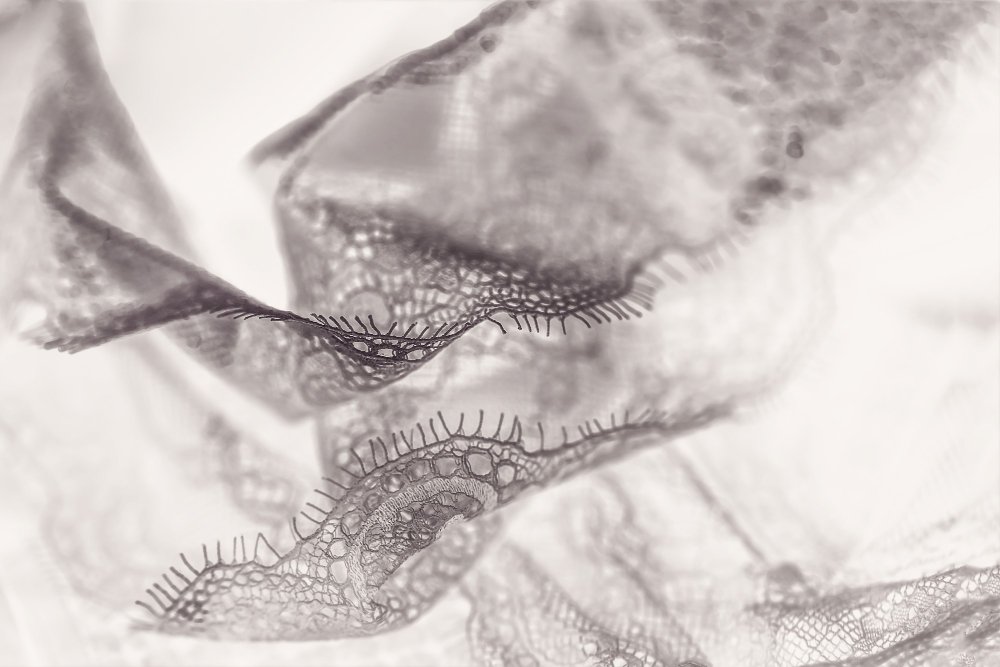Table of Contents
What is Cotton Lace Fabric?
Cotton lace fabric represents the perfect marriage of traditional craftsmanship and natural comfort. This delicate textile combines intricate openwork patterns with the soft, breathable qualities of natural cotton fibers, creating a material that’s both beautiful and functional.
Quick Definition
Cotton lace is an openwork fabric made from cotton fibers, featuring decorative patterns created through various techniques including weaving, knitting, or embroidering. Unlike synthetic alternatives, cotton lace offers natural breathability, skin-friendly softness, and authentic texture that improves with age.
Does Cotton Lace Exist?
Absolutely! Cotton lace not only exists but represents one of the most popular and accessible forms of lace available today. While historical lace was primarily made from silk or linen threads, cotton became the preferred material during the Industrial Revolution due to its affordability and ease of cultivation.
What is Lace Cotton Fabric Called?
Cotton lace goes by several names depending on its construction method and origin:
- Valenciennes cotton lace – Traditional French-style cotton lace
- Cotton guipure – Heavy cotton lace without a net background
- Cotton Chantilly – Fine cotton lace with floral patterns
- Machine cotton lace – Mechanically produced cotton lace
- Handmade cotton lace – Artisanal cotton lace varieties
Historical Context
Cotton lace emerged as a more affordable alternative to silk lace in the 17th century. The availability of cotton from colonial trade routes made it possible for European lace makers to create beautiful designs at lower costs, democratizing this luxury textile for broader social classes.
Discover the beauty and characteristics of cotton lace fabric in this detailed showcase
Properties and Characteristics
Understanding cotton lace’s unique properties helps you make informed decisions for your projects. These characteristics set it apart from both synthetic laces and other natural fiber alternatives.
Advantages
- Natural breathability – Cotton fibers allow air circulation
- Skin-friendly – Hypoallergenic and gentle on sensitive skin
- Absorbent – Wicks moisture away from the body
- Durable – Stronger than many synthetic laces when wet
- Improves with age – Becomes softer over time
- Easy to dye – Takes color beautifully
- Biodegradable – Environmentally friendly
Considerations
- Shrinkage – Can shrink 4-7% if not pre-treated
- Wrinkles easily – Requires careful pressing
- Fades in sunlight – Needs protection from UV exposure
- Takes longer to dry – Compared to synthetic alternatives
- Higher cost – More expensive than polyester lace
- Care requirements – Needs gentler handling than synthetics
Technical Specifications
| Property | Cotton Lace | Typical Range |
|---|---|---|
| Weight (GSM) | 40-180 GSM | Light to medium weight |
| Shrinkage Rate | 4-7% | Higher than synthetics |
| Moisture Absorption | 7-8% | Excellent |
| Tensile Strength | High when wet | Increases 20% when wet |
| Common Widths | 1/4″ to 60″ | Varies by application |
Does Cotton Lace Shrink?
Yes, cotton lace typically shrinks 4-7% during its first wash if not pre-shrunk during manufacturing. This is why pre-washing your cotton lace before starting any project is crucial. The shrinkage occurs primarily in the length rather than width, and proper care can minimize this effect.
How to Soften Cotton Lace
Cotton lace naturally softens with use and washing, but you can accelerate this process:
- Soak in lukewarm water with white vinegar (1:4 ratio) for 30 minutes
- Use a gentle fabric softener designed for delicates
- Air dry and gently stretch while damp
- Steam lightly to relax the fibers
Types of Cotton Lace
Cotton lace comes in numerous varieties, each with distinct characteristics suited for different applications. Understanding these types helps you choose the perfect option for your project.
By Production Method
Machine-Made Cotton Lace
Machine-made cotton lace represents about 90% of today’s lace market. Modern lace-making machines can produce intricate patterns consistently and affordably, making cotton lace accessible for everyday use.
Popular Machine-Made Types:
- Raschel Lace – Warp-knitted lace with geometric patterns
- Jacquard Lace – Computer-controlled patterns with complex designs
- Embroidered Lace – Machine embroidered on cotton net base
- Chemical Lace – Created by dissolving backing fabric
What is Handmade Lace Called?
Handmade cotton lace is often called by its specific technique name:
- Needle Lace – Created with a single needle and thread
- Bobbin Lace – Made using multiple threads wound on bobbins
- Crochet Lace – Handcrafted using crochet hooks
- Tatting – Knotted lace made with shuttles
By Pattern and Style
| Type | Characteristics | Best Uses |
|---|---|---|
| Chantilly | Fine cotton with floral motifs, scalloped edges | Bridal wear, evening gowns |
| Alençon | Fine needlepoint cotton lace, corded outlines | Luxury garments, heirloom pieces |
| Guipure | Heavy cotton lace, no net background | Structured garments, home décor |
| Valenciennes | Traditional cotton lace, geometric patterns | Trim, edging, accessories |
| Beaded Cotton Lace | Cotton base with bead embellishments | Special occasion wear |
Specialty Cotton Lace Types
Stretch Cotton Lace
Combining cotton with elastane or spandex creates stretch cotton lace, perfect for fitted garments and activewear applications. This type maintains cotton’s breathability while adding flexibility.
Organic Cotton Lace
Made from organically grown cotton without synthetic pesticides or fertilizers, this eco-friendly option appeals to environmentally conscious consumers and those with sensitive skin.
Cotton-Blend Lace
Blending cotton with other fibers creates unique properties:
- Cotton-Polyester – Reduces shrinkage, increases durability
- Cotton-Silk – Adds luster and strength
- Cotton-Linen – Enhanced texture and breathability
How Cotton Lace is Made
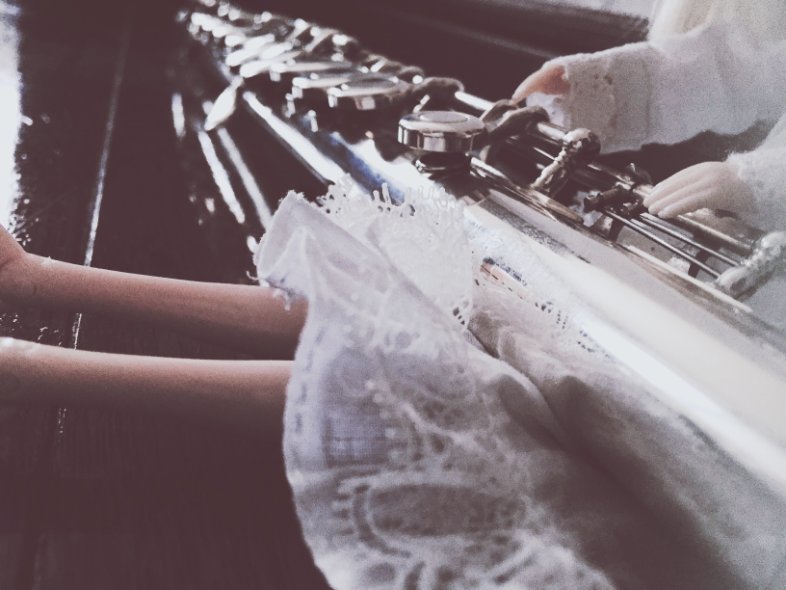
Understanding cotton lace production helps you appreciate its craftsmanship and choose quality products. The process varies significantly between handmade and machine-made varieties.
Traditional Handmade Process
Traditional cotton lace making is an art form requiring significant skill and patience. Here’s the step-by-step process:
Handmade Cotton Lace Steps:
- Cotton Preparation – High-quality cotton threads are selected and prepared
- Pattern Design – Detailed patterns are drawn on parchment or cardboard
- Thread Placement – Threads are positioned according to the pattern
- Lace Construction – Using needles, bobbins, or hooks to create the design
- Finishing – Edges are refined and loose threads secured
- Quality Check – Final inspection for consistency and defects
Modern Machine Production
Machine-made cotton lace uses advanced technology to replicate intricate patterns quickly and consistently:
Leavers Lace Machines
These traditional machines, some dating back to the 1800s, still produce the highest quality machine-made lace. They can create about 35 centimeters of lace per hour, working with multiple cotton threads simultaneously.
Raschel Machines
Modern computer-controlled machines can produce cotton lace much faster, creating hundreds of yards per day. While faster, they typically produce simpler patterns than Leavers machines.
Can You Make Lace with Cotton?
Absolutely! Cotton is an excellent material for lace making because:
- It’s strong enough to hold intricate patterns
- Takes dye well for colored laces
- Comfortable against skin
- More affordable than silk
- Available in various thread weights
Quality Control in Production
Quality cotton lace undergoes rigorous testing:
- Thread tension consistency
- Pattern accuracy
- Color fastness
- Shrinkage testing
- Strength testing
Cotton Lace vs Alternatives
Choosing between cotton lace and alternatives depends on your project requirements, budget, and preferences. Here’s a comprehensive comparison to help you decide.
Cotton vs Polyester Lace
| Aspect | Cotton Lace | Polyester Lace |
|---|---|---|
| Breathability | Excellent – natural airflow | Poor – synthetic barrier |
| Durability | Good – stronger when wet | Excellent – very strong |
| Cost | Moderate to high | Low to moderate |
| Care | Requires gentle handling | Easy care, machine washable |
| Shrinkage | 4-7% potential shrinkage | Minimal shrinkage |
| Environmental Impact | Biodegradable, sustainable | Non-biodegradable, petroleum-based |
| Feel | Soft, improves with age | Can be stiff or scratchy |
For more details on fabric comparisons, check out our cotton vs polyester guide.
Cotton vs Silk Lace
Cotton Lace Advantages
- More affordable than silk
- Better for everyday wear
- Easier to care for
- More durable in regular use
- Better for sensitive skin
Silk Lace Advantages
- Superior drape and flow
- Natural sheen and luxury feel
- Temperature regulating
- Traditional luxury appeal
- Stronger fiber structure
When to Choose Cotton Lace
Cotton lace is ideal for:
- Everyday garments and casual wear
- Children’s clothing and baby items
- Summer clothing and breathable garments
- Home décor projects
- Crafting and DIY projects
- People with sensitive skin
- Environmentally conscious projects
- Budget-conscious luxury alternatives
Price Comparison Guide
Understanding typical price ranges helps set realistic budgets:
- Machine cotton lace: $5-25 per yard
- Handmade cotton lace: $20-100+ per yard
- Polyester lace: $2-15 per yard
- Silk lace: $25-200+ per yard
Applications and Uses
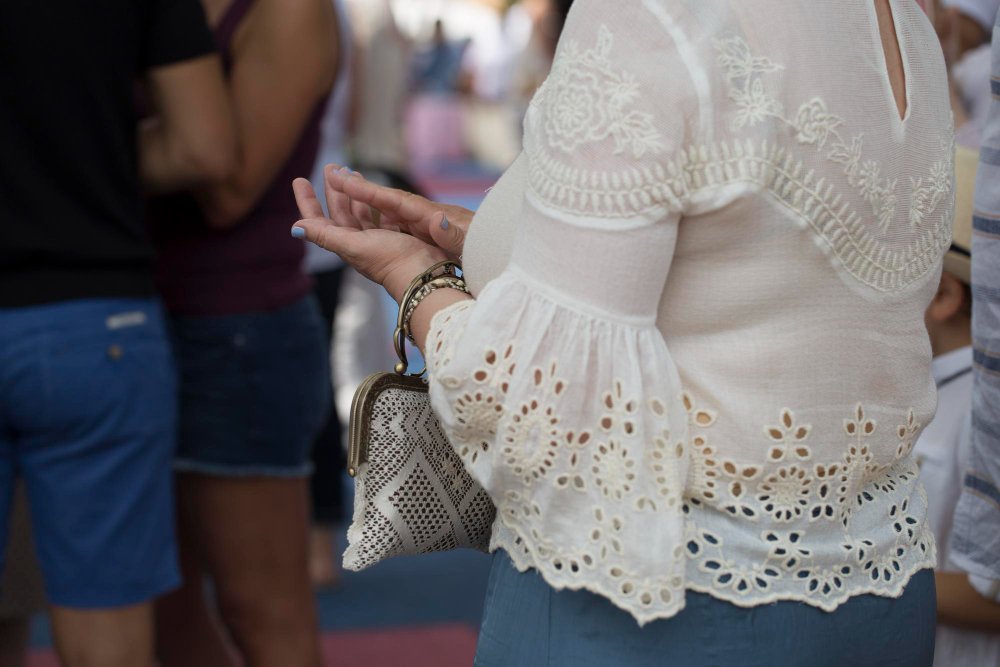
Cotton lace’s versatility makes it suitable for numerous applications across fashion, home décor, and crafting. Understanding these uses helps you choose the right type for your specific project.
Fashion and Apparel
Bridal and Wedding Wear
Cotton lace remains a popular choice for wedding attire due to its romantic appearance and comfort. Modern brides appreciate cotton lace’s breathability for outdoor weddings and warmer climates.
Bridal Cotton Lace Applications:
- Wedding gowns – Full overlays or accent panels
- Veils – Delicate edging or full lace veils
- Bridesmaid dresses – Coordinating lace details
- Accessories – Gloves, shawls, and hair pieces
Everyday Fashion
Cotton lace has moved beyond formal wear into everyday fashion, appearing in:
- Casual tops and blouses – Lace panels and sleeves
- Dresses – Both lined and unlined styles
- Lingerie – Comfortable, breathable undergarments
- Activewear – Stretch cotton lace in yoga and fitness wear
2025 Fashion Trends
Current fashion trends are incorporating cotton lace in innovative ways:
- Minimalist lace – Simple, clean-lined designs
- High-contrast applications – Black cotton lace over bright colors
- Athleisure integration – Lace panels in sporty designs
- Sustainable fashion – Organic cotton lace for eco-conscious brands
Home Décor Applications
Cotton lace transforms living spaces with its delicate beauty and practical benefits. Its natural fibers make it perfect for home environments where comfort and breathability matter.
Window Treatments
Cotton lace curtains and panels create beautiful light-filtering effects while maintaining privacy. The natural cotton fibers soften harsh sunlight without completely blocking illumination.
Curtains & Panels
Filter light beautifully while maintaining natural airflow
Bedding Accents
Pillow trims, sheet edging, and decorative throws
Table Linens
Runners, placemats, and tablecloth overlays
Decorative Accents
Lampshade covers, doilies, and wall hangings
Seasonal Home Décor
Cotton lace adapts beautifully to seasonal decorating:
- Spring – Fresh white cotton lace with floral motifs
- Summer – Light, airy cotton lace in natural tones
- Fall – Warm-toned cotton lace in amber and cream
- Winter – Rich cotton lace in deep colors or classic white
DIY and Crafting Projects
Cotton lace’s workability makes it perfect for various craft projects. Its natural fibers take dye well and can be easily manipulated for creative applications.
Cotton Lace Project Calculator
Calculate how much cotton lace you need for your project:
Results:
Popular DIY Projects
- Clothing embellishments – Adding lace trim to existing garments
- Home accessories – Decorative pillows and throws
- Wedding decorations – Centerpieces and venue décor
- Vintage-style crafts – Shabby chic and romantic themes
- Upcycling projects – Transforming old items with lace accents
Commercial Applications
Beyond personal use, cotton lace serves various commercial purposes:
- Fashion industry – Mass production of lace garments
- Hospitality sector – Hotel and restaurant linens
- Interior design – Professional decorating projects
- Costume design – Theater and film applications
- Religious textiles – Altar cloths and ceremonial garments
Buying Guide & Quality Assessment

Selecting quality cotton lace requires understanding what to look for and where to find the best options. This guide helps you make informed purchasing decisions.
Quality Indicators
Signs of Premium Cotton Lace:
- Uniform pattern – Consistent motifs throughout the fabric
- Even thread tension – No loose or overly tight areas
- Clean edges – Well-finished scalloping or straight edges
- Soft hand feel – Pleasant texture without stiffness
- Color consistency – No fading or uneven dyeing
- Proper drape – Falls naturally without stiffness
What to Avoid
Red Flags in Cotton Lace:
- Irregular patterns – Inconsistent motif sizes or spacing
- Loose threads – Visible fraying or unfinished edges
- Chemical odors – Strong synthetic smells indicating poor processing
- Excessive stiffness – Over-processed or heavily sized fabric
- Color bleeding – Dye transfer when slightly dampened
Testing Cotton Lace Quality
Before purchasing, perform these simple tests:
| Test | Method | Good Result |
|---|---|---|
| Hand Feel | Gently touch and manipulate | Soft, pliable, not scratchy |
| Light Test | Hold up to light | Even transparency, clear patterns |
| Stretch Test | Gently pull in different directions | Returns to shape without distortion |
| Edge Inspection | Examine borders and scallops | Clean, even, well-finished |
Where to Buy Cotton Lace
Online Sources
- Specialty fabric retailers – Mood Fabrics, B&J Fabrics
- Wholesale suppliers – For bulk purchases
- Artisan marketplaces – Etsy for handmade options
- International suppliers – Direct from lace-making regions
Physical Locations
- Local fabric stores – Touch and feel before buying
- Bridal shops – Often carry premium lace selections
- Upholstery suppliers – For home décor applications
- Craft stores – Limited but convenient options
Price Guidelines
Understanding typical pricing helps avoid overpaying:
Budget-Friendly ($3-15/yard)
- Machine-made cotton lace
- Simple patterns
- Standard widths
- Basic colors
Premium ($20-80/yard)
- Handmade or heritage techniques
- Complex patterns
- Custom widths
- Specialty colors or treatments
Certification and Standards
Look for these quality certifications:
- OEKO-TEX Standard 100 – Ensures no harmful chemicals
- GOTS (Global Organic Textile Standard) – For organic cotton lace
- Made in EU/USA labels – Often indicate higher quality standards
- Brand reputation – Established manufacturers with quality history
Understanding different lace types and characteristics can help you make better purchasing decisions.
Expert Working Tips
Working with cotton lace requires specific techniques and tools to achieve professional results. These expert tips help you handle cotton lace successfully in your projects.
Essential Tools and Supplies
Must-Have Tools for Cotton Lace:
- Sharp fabric scissors – For clean cuts without fraying
- Universal needles (size 70/10-80/12) – Appropriate for cotton fibers
- Fine pins – Silk pins leave minimal holes
- Rotary cutter with new blade – For precise straight cuts
- Teflon presser foot – Prevents snagging during sewing
- Seam ripper – For careful mistake correction
- Press cloth – Protects lace during ironing
Cutting Techniques
Proper cutting prevents fraying and ensures clean edges:
Cotton Lace Cutting Best Practices:
- Always cut with the grain when possible
- Use sharp scissors or rotary cutters
- Cut single layers to maintain pattern alignment
- Leave extra seam allowance for delicate areas
- Mark cutting lines with water-soluble markers
Sewing Techniques
Seaming Cotton Lace
Different seaming methods work better for various cotton lace types:
| Seam Type | Best For | Technique |
|---|---|---|
| French Seam | Delicate cotton lace | Encases raw edges completely |
| Flat Fell Seam | Sturdy cotton lace | Strong, flat finish |
| Overlock Seam | Stretch cotton lace | Prevents fraying, maintains stretch |
| Zigzag Seam | Quick finishes | Simple edge treatment |
For more detailed seaming guidance, check our seam allowance troubleshooting guide.
Thread Selection
Choose the right thread for invisible, durable seams:
- Cotton thread – Best compatibility with cotton lace
- Polyester thread – Stronger for stress points
- Silk thread – Luxury projects requiring perfect drape
- Invisible thread – For nearly invisible seaming
Handling Difficult Areas
Curved Seams
Cotton lace curves require special attention:
- Clip seam allowances on inside curves
- Notch seam allowances on outside curves
- Use bias tape for smooth curved finishes
- Steam lightly to shape curves
Joining Different Fabrics
When combining cotton lace with other materials:
- Pre-shrink all fabrics to the same degree
- Use interfacing to support lace in stress areas
- Grade seam allowances to reduce bulk
- Test seaming on scraps first
Pressing and Finishing
Safe Pressing Techniques
Temperature
Medium heat (cotton setting), never use high heat
Steam
Light steam or damp press cloth for best results
Protection
Always use a press cloth to prevent shine
Timing
Quick, light touches rather than prolonged pressure
For comprehensive sewing machine guidance, visit our troubleshooting guide and presser feet guide.
Common Mistakes to Avoid
- Using dull needles – Causes snags and pulls
- Sewing too fast – Can distort delicate patterns
- Skipping pre-shrinking – Leads to project distortion
- Overpressing – Can flatten dimensional patterns
- Ignoring grain direction – Causes bias stretch and distortion
Professional Finishing Touches
- Hand-rolled hems – For ultra-delicate edges
- Bound buttonholes – Better than machine buttonholes
- Covered buttons – Coordinated closures
- Invisible zippers – Maintain lace pattern flow
Care & Maintenance
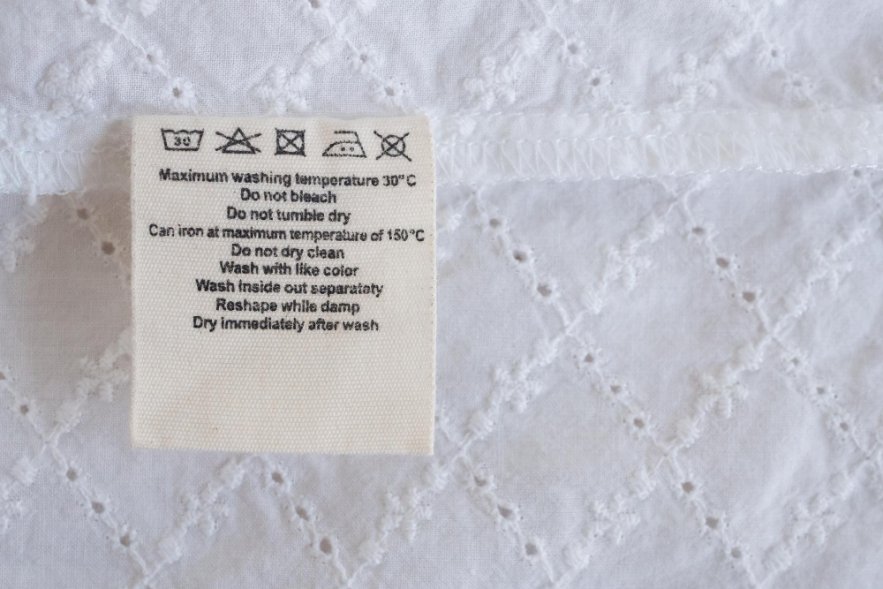
Proper care extends the life of cotton lace and maintains its beauty. Cotton lace requires gentle handling but is generally easier to care for than silk lace.
Washing Guidelines
Pre-Washing New Cotton Lace:
Always pre-wash cotton lace before using in projects to prevent shrinkage issues later:
- Soak in cool water for 30 minutes
- Gently agitate by hand
- Rinse in same temperature water
- Lay flat to dry completely
- Measure for any dimensional changes
Regular Cleaning Methods
Hand Washing (Recommended)
- Fill basin with cool to lukewarm water (30°C/86°F maximum)
- Add gentle detergent designed for delicates
- Submerge lace and gently squeeze soapy water through
- Soak for 10-15 minutes maximum
- Rinse thoroughly in clean water
- Gently squeeze out excess water (never wring)
- Lay flat on clean towel to dry
Machine Washing (When Necessary)
- Use mesh laundry bag to protect lace
- Select delicate/gentle cycle
- Cool water only
- Mild detergent, no fabric softener
- Remove promptly after cycle
Drying Techniques
Air Drying
Always air dry cotton lace flat on clean towels
No Heat
Never use clothes dryer – heat can damage cotton fibers
Indoor Drying
Dry away from direct sunlight to prevent UV damage
Shape While Damp
Gently reshape patterns while slightly damp
Storage Solutions
Short-Term Storage
- Clean before storing – Remove all soil and stains
- Completely dry – Any moisture can cause mildew
- Fold carefully – Follow natural pattern lines
- Use acid-free tissue – Between folds to prevent creasing
Long-Term Storage
Archive-Quality Storage:
- Store flat in acid-free boxes when possible
- Use muslin or cotton sheets as covers
- Avoid plastic bags (can trap moisture)
- Maintain stable temperature and humidity
- Check periodically for pest damage
- Refold along different lines annually
Stain Removal
Common Stains and Solutions
| Stain Type | Treatment | Notes |
|---|---|---|
| Food/Grease | Gentle dish soap, work from outside in | Treat immediately when possible |
| Makeup | Makeup remover, then gentle soap | Test on hidden area first |
| Sweat/Yellowing | White vinegar and water solution | Soak gently, then rinse thoroughly |
| Blood | Cold water and hydrogen peroxide | Never use hot water on blood |
| Wine/Juice | Club soda, then gentle detergent | Blot, don’t rub the stain |
Restoration and Repair
Minor Repairs
- Loose threads – Carefully weave back into pattern
- Small holes – Darn with matching cotton thread
- Separated seams – Re-stitch with original seam line
- Frayed edges – Trim carefully and finish appropriately
Professional Restoration
Consider professional help for:
- Antique or heirloom cotton lace
- Extensive damage or staining
- Complex pattern reconstruction
- Museum-quality preservation needs
Seasonal Care
Summer Care
- More frequent washing due to increased wear
- Protect from excessive sun exposure
- Ensure complete drying in humid conditions
Winter Storage
- Check storage areas for adequate ventilation
- Monitor for pest activity
- Avoid storing near heat sources
For more fabric care guidance, explore our comprehensive cotton care guide.
2025 Trends & Innovations
The cotton lace industry continues evolving with new trends, sustainable practices, and innovative applications. Understanding these developments helps you stay current with fashion and market demands.
Sustainability Focus
Eco-Friendly Cotton Lace Trends:
- Organic cotton lace – Grown without synthetic pesticides
- Recycled cotton lace – Made from post-consumer cotton waste
- Low-impact dyes – Natural and eco-friendly coloring methods
- Local production – Reduced transportation carbon footprint
- Circular design – Lace designed for recycling and upcycling
Design Innovations
Digital Integration
Modern technology enhances traditional cotton lace making:
- Computer-aided design – Precise pattern creation and customization
- 3D printing integration – Hybrid techniques combining traditional and modern methods
- Smart textiles – Cotton lace with embedded technology for temperature regulation
- Color-changing properties – Thermochromic treatments for interactive fashion
Pattern Trends
- Minimalist geometrics – Clean lines and simple shapes
- Oversized florals – Bold, statement-making botanical motifs
- Mixed-scale patterns – Combining different pattern sizes
- Cultural fusion – Incorporating global design elements
Market Applications
Athleisure Integration
Cotton lace finds new applications in athletic and casual wear:
- Stretch cotton lace panels in yoga wear
- Breathable lace inserts in activewear
- Casual cotton lace trim on sweatshirts
- Athletic-luxury hybrid garments
Home Wellness Trend
Cotton lace supports the growing home wellness movement:
- Air-purifying plant hangers with cotton lace
- Meditation space décor featuring natural cotton lace
- Wellness-focused bedroom textiles
- Natural fiber emphasis for healthier living spaces
Color Predictions
Trending Colors 2025
- Earth tones – Warm browns, terracotta
- Sage green – Calming natural green
- Soft lavender – Gentle purple tones
- Warm whites – Cream and ivory variations
Classic Staples
- Pure white – Always in demand
- Black – Sophisticated contrast
- Navy – Versatile neutral
- Blush – Romantic feminine appeal
Production Innovations
Automated Quality Control
Advanced technology improves cotton lace quality:
- AI-powered pattern inspection
- Automated thread tension monitoring
- Real-time defect detection
- Predictive maintenance systems
Customization Capabilities
Modern production allows for greater customization:
- Small-batch custom patterns
- Personalized color matching
- Made-to-order sizing
- Digital pattern libraries for instant access
Consumer Preferences
Value Drivers
What consumers prioritize in 2025:
- Sustainability credentials – Environmental impact matters
- Versatility – Multi-purpose applications preferred
- Quality over quantity – Investment pieces vs. fast fashion
- Authenticity – Genuine craftsmanship appreciation
- Comfort – Natural fibers for skin contact
Shopping Behaviors
- Increased online purchasing with detailed specifications
- Video tutorials driving DIY project interest
- Social media influence on color and pattern choices
- Demand for transparent supply chain information
Stay current with broader fabric trends by exploring our 2025 fabric trends guide.
Frequently Asked Questions
Get answers to the most common questions about cotton lace fabric, from basic properties to advanced working techniques.
Yes, cotton lace typically shrinks 4-7% during its first wash if not pre-shrunk during manufacturing. To prevent shrinkage issues:
- Always pre-wash cotton lace before starting projects
- Use cool water for washing
- Air dry flat rather than using a dryer
- Consider buying pre-shrunk cotton lace for critical applications
Cotton and polyester lace differ significantly in properties:
- Breathability: Cotton lace allows air circulation; polyester can feel stuffy
- Comfort: Cotton is softer and more skin-friendly
- Durability: Polyester is stronger but cotton gets softer with age
- Care: Cotton requires gentler handling; polyester is easier to maintain
- Cost: Cotton lace is generally more expensive than polyester
- Environmental impact: Cotton is biodegradable; polyester is not
Yes, cotton lace can be successfully dyed at home using natural cotton-friendly dyes:
- Use fiber-reactive dyes for best color fastness
- Pre-wet the lace in cool water before dyeing
- Follow dye manufacturer’s instructions for cotton fabrics
- Handle gently during the dyeing process to avoid pattern distortion
- Test on a small sample first to check color results
- Consider professional dyeing for valuable or complex pieces
Several techniques help prevent fraying in cotton lace:
- Clean cutting: Use sharp scissors or rotary cutters
- Seam finishing: Serge, zigzag, or pink edges immediately after cutting
- French seams: Encase raw edges completely
- Bias binding: Finish edges with matching or contrasting bias tape
- Fray check: Apply liquid seam sealant to cut edges (test first)
- Proper storage: Fold along pattern lines to minimize stress on edges
Medium-weight cotton lace (80-120 GSM) is ideal for beginners because:
- It’s easier to handle than very delicate types
- More forgiving of sewing mistakes
- Less likely to snag or tear during learning
- Good for both garments and home décor projects
- Widely available and moderately priced
- Suitable for both hand and machine sewing
Several tests help identify cotton lace:
- Burn test: Cotton burns with an orange flame and ash residue; synthetics melt
- Feel test: Cotton feels softer and more natural than most synthetics
- Absorption test: Cotton absorbs water quickly; synthetics repel it
- Price indicator: Cotton lace is typically more expensive
- Label check: Quality manufacturers clearly label fiber content
- Professional assessment: When in doubt, consult fabric experts
Proper storage preserves vintage cotton lace for generations:
- Clean thoroughly: Remove all stains and soil before storage
- Acid-free materials: Use acid-free boxes and tissue paper
- Flat storage: Store flat when possible to prevent creasing
- Climate control: Maintain stable temperature and humidity
- Avoid plastic: Use breathable cotton or muslin covers
- Regular inspection: Check periodically for pest damage or deterioration
- Professional conservation: Consider museum-quality storage for valuable pieces
Cotton lace can be machine washed with proper precautions:
- Use mesh bags: Protect lace from snagging on other items
- Gentle cycle: Select the most delicate machine setting
- Cool water only: Hot water can cause shrinkage and damage
- Mild detergent: Avoid harsh chemicals and fabric softeners
- Separate loads: Wash with similar delicate items only
- Air dry: Never put cotton lace in the dryer
- Hand washing preferred: When possible, hand wash for best results
Several factors contribute to yellowing in cotton lace:
- Age: Natural oxidation process in cotton fibers
- UV exposure: Sunlight breaks down cotton fibers
- Body oils: Skin contact leaves oils that oxidize
- Storage conditions: Poor storage can accelerate yellowing
- Chemical residues: Soap, perfume, or cleaning product residues
- Prevention: Proper cleaning, UV protection, and climate-controlled storage help prevent yellowing
Cotton lace can be excellent for baby clothes when chosen and used properly:
- Benefits: Natural, breathable, soft, and hypoallergenic
- Safety considerations: Avoid loose threads that could catch tiny fingers
- Comfort: Cotton lace is gentler than synthetic alternatives
- Easy care: Machine washable for busy parents
- Design tips: Use as trim rather than main fabric for durability
- Quality matters: Choose well-made cotton lace without rough edges
Conclusion
Cotton lace fabric represents a perfect balance of traditional craftsmanship, natural comfort, and versatile functionality. Throughout this comprehensive guide, we’ve explored every aspect of this remarkable textile, from its historical origins to modern applications and future trends.
Key Takeaways
Essential Points to Remember:
- Natural Benefits: Cotton lace offers breathability, comfort, and skin-friendly properties that synthetic alternatives cannot match
- Quality Matters: Investing in quality cotton lace pays dividends in durability, appearance, and performance
- Proper Care is Crucial: Following correct care procedures significantly extends the life and beauty of cotton lace
- Versatile Applications: From haute couture to home décor, cotton lace adapts to countless creative applications
- Sustainable Choice: As an biodegradable natural fiber, cotton lace supports environmentally conscious practices
Recommendations for Different Users
For Fashion Designers
Cotton lace offers creative flexibility while meeting consumer demands for comfort and sustainability. Consider cotton lace for:
- Breathable summer collections
- Comfortable everyday luxury pieces
- Sustainable fashion initiatives
- Versatile pieces that transition from day to evening
For Home Decorators
Cotton lace brings timeless elegance to interior spaces while providing practical benefits:
- Light-filtering window treatments that maintain airflow
- Natural fiber décor that supports wellness trends
- Durable textiles that improve with age
- Versatile pieces that work with multiple design styles
For DIY Enthusiasts
Cotton lace’s workability makes it perfect for crafting projects:
- Start with medium-weight cotton lace for easier handling
- Pre-wash all cotton lace before beginning projects
- Invest in proper tools for best results
- Practice techniques on scraps before working on final projects
For Consumers
When shopping for cotton lace items, prioritize:
- Quality construction and even pattern distribution
- Proper care instructions from manufacturers
- Certifications for organic or sustainable production
- Versatile pieces that justify the investment
Future Outlook
The cotton lace industry continues evolving with technological advances and changing consumer preferences. We can expect to see:
- Increased sustainability focus – More organic and recycled cotton lace options
- Technology integration – Smart textiles and interactive elements
- Customization capabilities – On-demand patterns and colors
- Global accessibility – Better availability of quality cotton lace worldwide
- Educational resources – More learning opportunities for traditional techniques
Making the Right Choice
Whether you’re selecting cotton lace for a special occasion garment, a home décor project, or everyday wear, remember these key factors:
Choose Cotton Lace When You Want:
- Natural breathability and comfort
- Sustainable, eco-friendly materials
- Timeless beauty that improves with age
- Skin-friendly properties
- Authentic texture and drape
- Good value for investment pieces
Consider Alternatives When You Need:
- Minimal care requirements
- Maximum durability in harsh conditions
- Lowest possible cost
- Stretch properties
- Resistance to shrinkage
- Quick-dry properties
Final Words
Cotton lace fabric embodies the best of both worlds: the heritage of traditional craftsmanship and the practicality of modern natural textiles. As we move forward into 2025 and beyond, cotton lace continues to play a vital role in sustainable fashion, comfortable living, and creative expression.
Whether you’re drawn to cotton lace for its environmental benefits, its comfort properties, or simply its timeless beauty, you’re choosing a textile with centuries of proven performance and endless possibilities for creative application.
By understanding cotton lace’s properties, caring for it properly, and using it thoughtfully in your projects, you become part of a tradition that values quality, craftsmanship, and natural beauty. This investment in knowledge and quality materials pays dividends in both the immediate satisfaction of working with superior materials and the long-term enjoyment of pieces that truly stand the test of time.
Start Your Cotton Lace Journey
Ready to work with cotton lace? Begin with a small project using quality materials, proper tools, and the techniques outlined in this guide. With patience and practice, you’ll discover why cotton lace has remained a favorite textile for generations of creators and continues to inspire new applications in our modern world.
For additional resources on fabric selection and care, explore our comprehensive guides on lace fabric types, natural vs synthetic fabrics, and specialized techniques in our beginner’s sewing guide.

